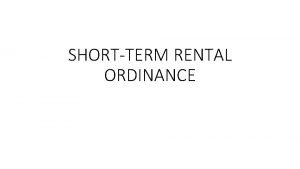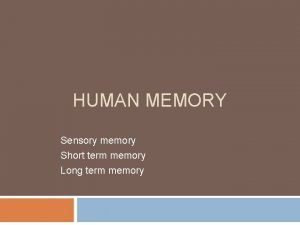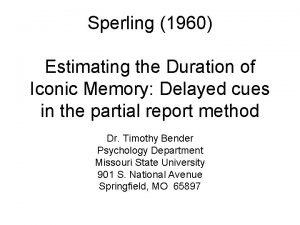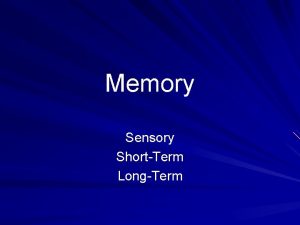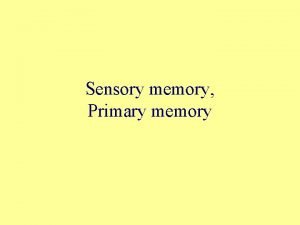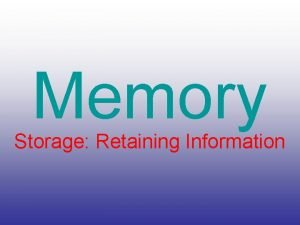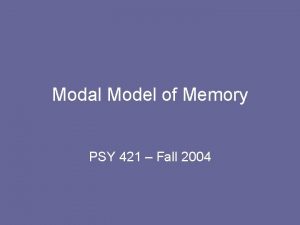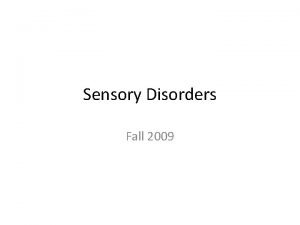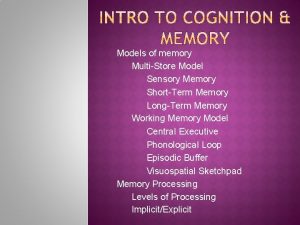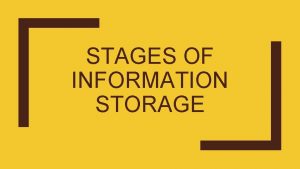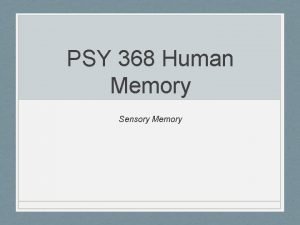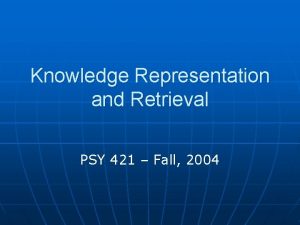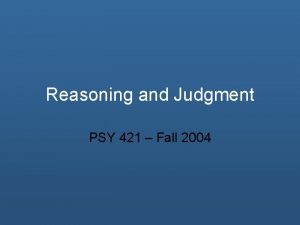Sensory and ShortTerm Memory PSY 421 Fall 2004














- Slides: 14

Sensory and Short-Term Memory PSY 421 – Fall 2004 1

Overview Sensory Memory (Chapter 3, pp. 102 -110) n Short-Term Memory (Chapter 4, pp. 134 -157) n How this fits together with what we have learned and what we will learn n 2

Sensory Memory n Part of the Information-Processing Model of Memory (Atkinson-Shiffrin, 1968) Information/ Stimuli Sensory Stores (one per modality) Attention Short-Term Store Rehearsal Long-Term Store Retrieval n Visual Sensory Memory (aka: iconic memory) Partial vs. Whole Report n Visual Masking n Duration Estimation n 3

Visual Sensory/Iconic Memory n Precategorical Nature n Iconic Memory – who cares! Useful if you are reading during a lightening storm n Important for preventing overloading of cognitive system n 4

Auditory Sensory Memory Echoic Memory n Everyday problem – if we didn’t have echoic memory, would be able to remember the beginning of a sentence said aloud by the time we reached the end? n Partial vs. Whole Report n n Modality and Suffix Effects 5

Partial vs. Whole Report n George Sperling (1960) – how much information could be taken in during a glance of a very briefly presented stimulus? A W Q n n n C T R K P D L Z M T-scope presentation for no-fade “screen” refresh Present matrix for 50 msec Tone – subjects were to report everything in the matrix (whole report) – 3 to 4 letters typically reported Partial Report = High tone – subjects were to report top row - 3 of the 4 letters typically reported; mid and low tones too Duration between presentation and tone was important – more than a quarter of a second, only 50% could be reported 6

Precategorical Acoustic Store n Evidence for n Evidence against 7

Short-Term Memory (STM) Also known as Working Memory, primary memory n Set of processes that we use to hold and rehearse information that occupies our current awareness n Is this really different from Long-Term Memory? n n Characteristics of STM Limited Duration n Limited Capacity n 8

Forgetting in STM Decay – loss of information due to the passage of time n Interference – loss of information due to negative influence from the presentation of other information n 9

Working Memory More elaborate conception of STM n Baddeley and colleagues – primary researchers n Working Memory (WM) is a set of closely interacting subsystems that combine to subserve a hot of higher-level mental processes n Subsystems n Articulatory Loop n Visual-Spatial Sketch Pad n n Central Executive – THE system 10

Articulatory Loop Phonological Store = holds information temporarily n Subvocal Rehearsal = just what is appears to be n n Articulatory Suppression 11

Visual-Spatial Sketchpad Responsible for storage and manipulation of visual and spatial information n Seems to work independently from articulatory loop n 12

Central Executive Articulatory Loop and Visual-Spatial Sketchpad feed into this system n Like the “capacity allocator” of the attentional system n Involved in higher order processing like problem solving and language comprehension n 13

Putting it all together Sensations Perceptual processes Attention Short-Term Memory Long-Term Memory Working Memory Central Executive Articulatory Loop Visual-Spatial Sketchpad 14


